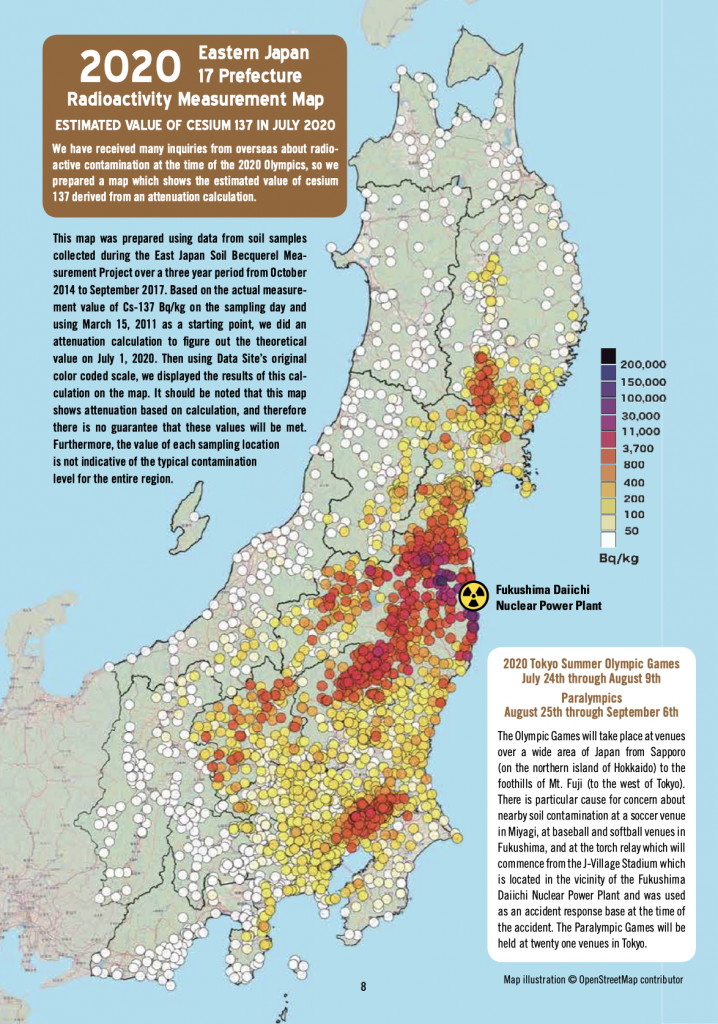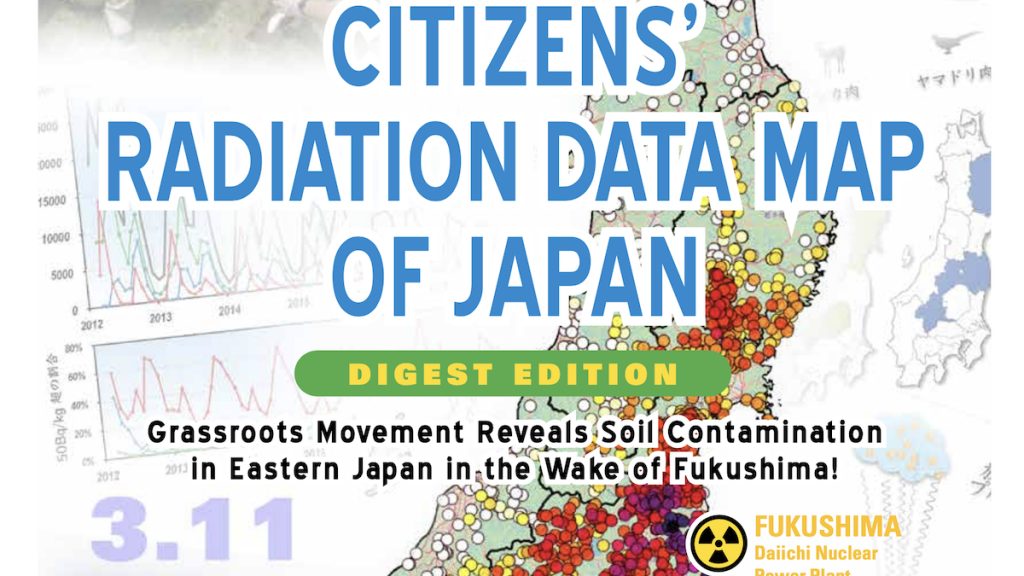
As a result of this investigation, [Minna-no Data Site] determined that the radioactive contamination was by no means limited to Fukushima Prefecture and that one hundred years from now there will still be several highly-contaminated areas where humans should not live.
Uninhabitable: Booklet by Citizen Scientists Uncovers True Extent of Radioactive Contamination in Japan’s Soil and Food

“As a result of this investigation, we determined that the radioactive contamination was by no means limited to Fukushima Prefecture and that one hundred years from now there will still be several highly-contaminated areas where humans should not live.
Now, eight years after the accident, not only has the government yet to establish a criterion for radioactive concentration in the soil, but the authorities are continuing to enforce the policy of compelling people to return to their homes if the air dose rate goes below 20 mSv/year.”
By:
From Minna-no Data Site, a citizen’s collaborative radioactivity monitoring project
Minna-no Data Site (Everyone’s Data Site) is a network of 30 citizens’ radioactivity measurement laboratories from all over Japan.
After the 2011 Fukushima accident, many independent citizen-operated radioactivity measurement laboratories sprang up across Japan.
In September 2013, a website called “Minna-no Data Site” was established in an effort to integrate all of the radioactivity measurement data into a common platform and disseminate accurate information in an easy-to-understand format.
As of July 2019, the Data Site website is home to approximately 16,000 cases of food measurement data, more than 3,400 cases of soil measurement data, and 1,700 cases of environmental samples (ash, river water, etc).
This English language version of the book is a digest version of our bestselling Japanese book, Illustration: 17 Prefecture Radioactivity Map & Close Analysis which was self-published in November 2018, and was awarded the Japan Congress of Journalists Prize in July 2019.
This booklet shows the actual amount of radioactive contamination caused by the March 2011 Fukushima Daiichi Nuclear Power Plant accident, as revealed by Japanese citizen scientists.
In the aftermath of the accident, citizens around Japan began to question the Japanese government’s initial radiation exposure assessment, the scope of their radioactivity measuring, and their method of information disclosure. With the aim of reducing citizen exposure to radiation, we established Minna-no Data Site, an independent nonprofit network of radioactivity-measuring laboratories, to conduct extensive food measurements and release this information to the public.
More specifically, over a three-year period starting from October 2014, we measured the concentration of radioactivity (cesium 134 and cesium 137) in the soil (in Bq/kg) as part of the “East Japan Soil Becquerel Measurement Project” and publicized the results online as a collection of maps.
According to legislation enacted five years after the Chernobyl accident, Russia, Ukraine, and Belarus were responsible for measuring both air dosage (μSv/h) and soil concentration (Bq/m2). And using these measurements, the authorities were required to establish criteria for relocation and compensation. The Chernobyl legislation guarantees relocation and recuperation rights to residents from areas where the exposure dose was estimated to be above 1mSv/year.
In contrast, after the Fukushima Daiichi Nuclear Power Plant accident, soil measurements were more or less not conducted outside of Fukushima Prefecture, and the government has only published estimated numbers of the deposition amount of radioactive cesium and the air dose rate one meter above the ground. The soil concentration figures released by the government are nothing more than estimates, and because the method of display was just an approximation, it is impossible to correctly ascertain the actual amount of contamination in areas where citizens actually live.
In order to address this unsatisfactory state of affairs, we solicited the cooperation of citizens from around the country to help us carry out this soil measurement project in an attempt to fully grasp the total amount of radioactive fallout which fell on eastern Japan (excluding Hokkaido) as a result of the triple meltdown at the Fukushima Daiichi NPP.


As a result of this investigation, we determined that the radioactive contamination was by no means limited to Fukushima Prefecture and that one hundred years from now there will still be several highly-contaminated areas where humans should not live.
Now, eight years after the accident, not only has the government yet to establish a criterion for radioactive concentration in the soil, but the authorities are continuing to enforce the policy of compelling people to return to their homes if the air dose rate goes below 20 mSv/year.
Seen from the standpoint of international standards of public health and radiological protection we cannot turn a blind eye to this unacceptable situation. With the Summer Olympics and Paralympics scheduled to be held in Tokyo in 2020*, we decided to publish this booklet in order to respond to questions and concerns from people around the world about the current state of radiation contamination in Japan. (*Since publication, the Tokyo Olympics were postponed until 2021 due to the Covid-19 pandemic.)
With the publication of this English booklet, we are hoping to inform people around the world about the actual amount of contamination in Japan, and at the same time, we are calling on the Japanese government to correct the following two problems:
CORRECTION OF THE DOUBLE STANDARD CONCERNING RADIOACTIVE MATERIALS 100 Bq/kg AND 8,000 Bq/kg
With regards to the clearance rule for radioactive materials, prior to the Fukushima Daiichi Nuclear Power Plant accident if the level of radioactivity was more than 100 Bq/kg there was a strict storage obligation.
However, with regards to radioactive contamination derived from the Fukushima accident, the government is permitting anything less than 8,000 Bq/kg to be incinerated or disposed of as ordinary waste, an irresponsible policy which leads to the unnecessary spread of radioactive materials.
We are calling on the Japanese government to correct this double standard and are demanding a return to the pre-accident clearance level of 100 Bq/kg.
Also, with regards to soil contamination, we are asking the government to not rely simply on the air radiation dose (sieverts) as they have been doing up until now. Instead, we are calling on them to guarantee appropriate rights of evacuation and compensation that meet international standards based on zone classification depending on the soil concentration of radioactive material.

30 citizens’ radioactivity monitoring laboratories from across Japan are part of the Minna-no Data Site project.
RESTORING THE ANNUAL PUBLIC DOSE LIMIT FROM 20 mSv TO THE PRE-ACCIDENT LEVEL OF 1mSv A YEAR
The Japanese government has not yet cancelled the nuclear power accident state of emergency declaration, which was enacted on March 11, 2011.
Based on this declaration, the public dose limit was raised from 1mSv/year to 20 mSv/year and the government is forcefully requiring evacuees to return to their homes in areas where the dose limit does not exceed 20 mSv/year.
We are calling on the authorities to abolish the 20 mSv standard repatriation policy and to return to the pre-accident public standard annual dose limit of 1 mSv.
HELP NEEDED
Minna-no Data Site is an entirely citizen supported group that is now running into financial difficulties, with funds likely to run out next spring, and the postponed 2020 Tokyo Olympic Games still planned for the summer of 2021. For this reason, among others, the group is endeavoring to raise funds through the distribution of this booklet. You can donate to their cause by going to our Donor Perfect page here and choosing Japan Radiation Maps from the pulldown menu to designate your gift. (Please be sure to do this as otherwise we cannot tell that the donation is specifically for Minna-no Data Site).
You can also purchase an e-book version of the booklet here: https://minna-no-datasite.stores.jp/items/5e48c64ccf327f78ff411139. For Amazon users, a digital version is also available from that site.
If you would like a hard copy of the (English language version) booklet, please contact the Manhattan Project for a Nuclear-Free World in New York by going to their website, or you can email your request for a booklet directly to this address: mdsbookorder@mp-nuclear-free.com
Headline image is the cover of the English language version of the booklet available for purchase.
